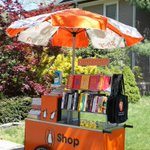| http://www.emeraldinsight.com |
 The wheel of retailing theory suggests that retailers enter at the low-price, low-service point in competitive positioning, then trade-up over time to better merchandise and better service at higher prices. This leads to the vulnerable phase, where low-price newcomers start to chip away at the market share of now-established stores.
The wheel of retailing theory suggests that retailers enter at the low-price, low-service point in competitive positioning, then trade-up over time to better merchandise and better service at higher prices. This leads to the vulnerable phase, where low-price newcomers start to chip away at the market share of now-established stores. In the history of U.S. retailing, an early point of competitive entry was pushcarts and itinerant merchants who roamed city streets and country roads carrying their inventory with them, going to where customers lived and worked. After major retail chains became the dominant force in the industry, malls sometimes introduced pushcarts to give independent retailers and local craftspeople a chance to break into the market and reach customers at a reasonable cost. In turn, successful pushcart operators might open a store, trade-up, and so on.
Now the retail world is seeing the wheel of retailing return to its roots yet again. Penguin Books has begun taking its inventory on the road in trucks (aka mobile stores or possibly pop-ups) and pushcarts.
Of course, this 21st century pushcart is supported by Twitter announcements of its location plus Facebook photos and comments. Penguin's web site has a map showing locations, as well. And Penguin's blog includes posts about the truck, which was inspired by the food truck craze sweeping the nation.
Actual sales may be less important than local publicity and brand reinforcement. I like this turn of the retailing wheel because it brings the industry back to one-to-one interaction.

No comments:
Post a Comment
Note: Only a member of this blog may post a comment.